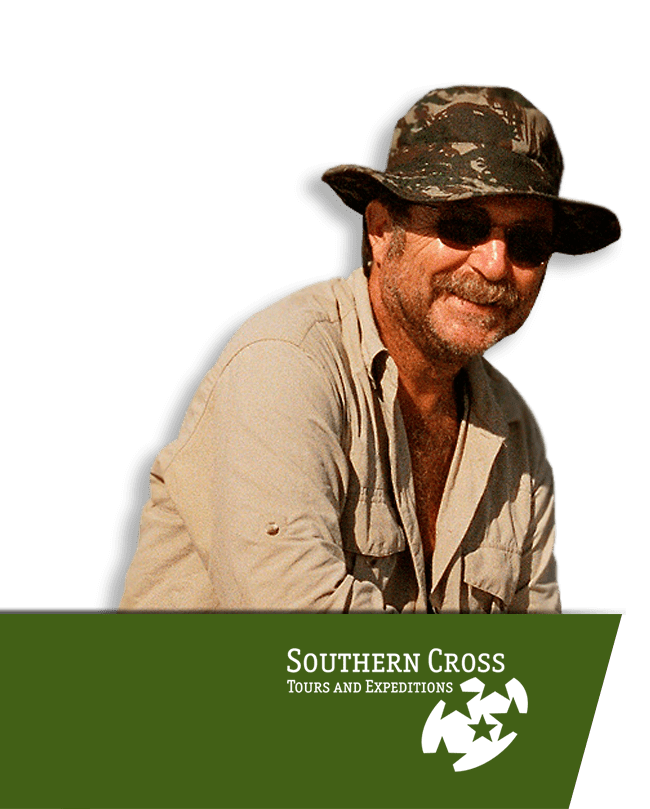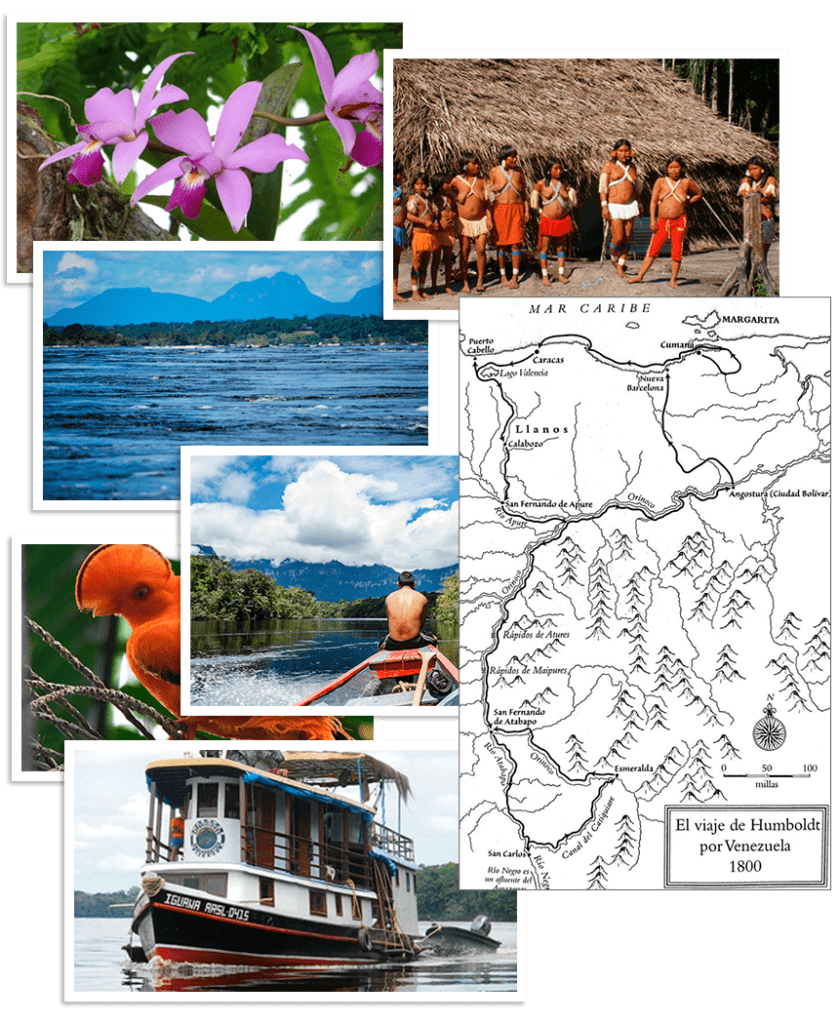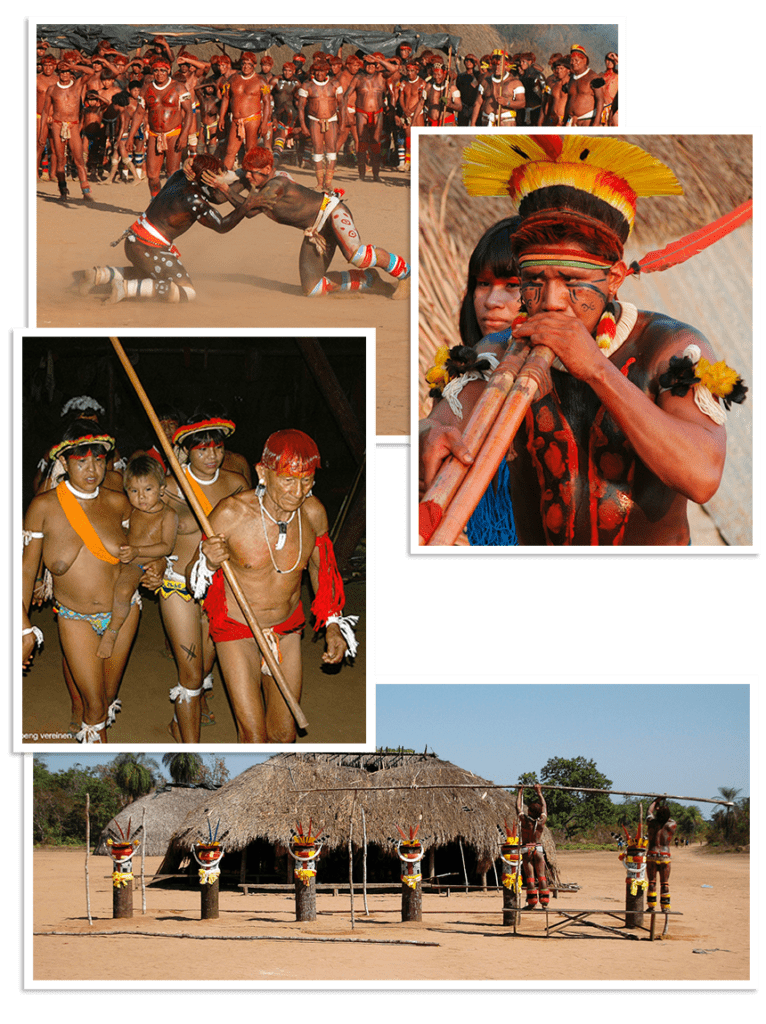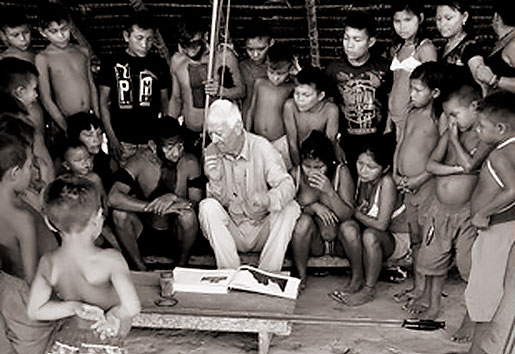
Peter Rohmer
More than five decades ago, a young German left home with nothing more in his pockets than curiosity, tenacity and guts to know the world. Over the course of the years, he acquired five languages, lived in multiple continents, and learned to survive, not only economically but also through willpower and determination.
Peter Rohmer understands how to talk himself out of a tough situation. As it happened, he found himself on the business end of a gun several times back in his early trailblazing days. A man of many talents, a great love of this gigantic country called Brazil, its nature and inhabitants, Peter carved out his first expeditions into the deepest Amazon wilderness. He went to places so far that it would take several days just to get there. His passion for spectacular and pristine landscapes, its remote jungles and rivers, the warm friendship of its people and the unique creatures that populate this awesome environment, is infectious.
The trip of your lifetime
Your Amazon travel adventure - My commitment
Our close up tours to the Brazilian Amazon provide unique insights in a fascinating environment that boost the greatest biodiversity on the planet. Attractive and challenging expeditions into the far and untouched corners of the Brazilian Amazon offer awesome experiences to both the adventurous nature lover and the natural history pro.
Exploring the impenetrable depths of the Amazon Rainforest and traveling on its rivers with you we meet with indigenous tribes and local caboclos. Both are respected participants in our operations and direct beneficiaries of our activities in the area.
If you are looking for an authentic trip to the Brazilian Amazon, drop me a line. Trust me I will make it happen.
These are the cornerstones of our 25 years success story:
Matching price-performance ratio
Customer proximity and careful ahead planning
Customized itineraries based on individuality, authenticity and sustainability
Long lasting and reliable relationship with local partners
GREAT NEWS
pre schedule of 2 new and amazing expeditions to the heart of the Amazon of Venezuela and Brazil

NEW : Meet the Giants
from the Orinoco to the Amazon
Follow the tracks of the famous 18th century explorer, geologist, naturalist, humanist and philosopher Alexander von Humboldt.
One of the last great travel adventures of our time.
- An awesome journey through the largest river system and continuous Rain Forest on the planet
- Travel the Giants: from the Orinoco to the Amazon
- Alongside the lost world of the mystical Autana Tepuis
- Explore the most distant and untouched portions of the Amazon Rainforest
- Deep and up-close experiences during nights in the jungle at Rio Siapa
- Meet and understand the famous Yanomami and other indigenous people of both Venezuela and Brazil
- The route : https://www.google.com/maps/d/edit?mid=1c1oOQ7Cke19yn7owVgIAIldv2iprhGc&usp=sharing
Travel dates 2024:
June 10th – June 28th, 2024
July 15th – August 02nd, 2024
August 12th – August 30th, 2024
September 16th – October 04, 2024
Dead-line for reservations: February 15th, 2024
- Group size limited from 4 – 6 traveller;
- Price as of 10.500 US$ per person;
- Please ask for details and itinerary:
- Peter Rohmer: request@scte-brazil.com

NEXT: THE QUARUP
Witness the famous mortuary ritual carried out by the native tribes of the Upper Xingu River in the Amazon
– Early reservations suggested –
The sacred QUARUP ritual is celebrated by the indigenous tribes of the Upper Xingú River in the state of Mato Grosso maintaining thus traditions and culture of the people on the Xingú river. A tradition passed from father to son for generations.
The celebrations are attended by up to 1000 participants from various ethnic groups, such as the Kamayurá, Kuikuro, Mehinako, Kalapalo, Matipu, Waurá, Kaiabi and Aweti. The ritual honours the death of a beloved one and is held always the year following the death .
An important part of the QUARUP ritual is the famous Huka Huka wrestling match. For this, the fighters of all ethnic groups prepare themselves by painting their entire body, including their hair, in a special way. The event is exremly colourful and exotic
Travel dates 2024:
July 30th – August 8th 2024
Price:
- The Quarup Ritual as of 8.350 US$ per person;
- The Quarup package combined with Jaguar Photo Safari as of 5.200 US$ per person;
Please ask for details and itinerary: Peter Rohmer request@scte-brazil.com
Amazon Tours and Expeditions
With Peter Rohmer and Southern Cross
Amazon Tours
Jaú National Park and Further
Amazon Adventure
This 8-day itinerary offers an insight on past, present and future of the Amazonian environment. The tour starts offering interesting visits in and around Manaus, the gate way to the deeper Amazon.
Departing by boat from Novo Airão two Nationalparks, Anavilhanas and the biggest in Brazil Jaú,will unfold their spectacular natural wonders while local caboclos and indigenous people impress the visitor by their simple and sustainable way of living from the forest and river.
amazon-travel-brazil.com
Testimonials
Dear Peter!
Shortly before our journey finally began, you wrote us that it would be one of our "nicer" trips: knowing full well that that was an understatement ...! :)))
Based on a few conversations with us, you have organized a trip tailored to our needs that we could not have wished for better - because we were at the end of our tether and after these 2 weeks we feel as if we were transformed and enchanted:
Something like that is just priceless. Thank you!
Everything was perfectly organized, the schedule was perfectly coordinated, but we still had peace and quiet and were able to enjoy the country and its people.
Really: it was something very special - we felt like we were in paradise and are still completely filled with the experiences and encounters, it is accordingly difficult to arrive at everyday life ...
Thanks to the people from Casa Caboclo, we were welcomed so lovingly and attentively and felt comfortable from the first moment! It was difficult for us to say goodbye ...
Then the Lençóis Maranhenses dunes - an incredible natural wonder !!!
The boat trip with the "Iara" and her wonderful crew on the Rio Negro was awesome: With excursions in the jungle, animal and plant observation, with happiness and their kindness, Jorge, Lucia, Edicarlo, Marlé made these days to an extraordinary experience. Marlé spoiled us all with the most delicious dishes. And when we parted there was a surprise that touched us deeply ...
But we would also like to thank this opportunity to thank all the other guides and helpers who were involved in the success!
We look forward to the promised meeting in Berlin!
With kind regards,
Christiane and Matthias, Berlin
Dear Peter,
back to our everyday life in Germany, we would like to sincerely thank Southern Cross Tours & Expeditions for the excellent organisation of our Amazon tour. My daughters and I loved it – what a contrast to Rio and Sao Paulo. We have returned from the Amazon full of new impressions and great memories. The decision to explore parts of the Anavilhanas and the Jaú National park by boat was the only right one. And as you had predicted we did not feel ready to leave this paradise yet after 5 days.
As I said, the trip was amazing. I was sceptical at the beginning, also because of the long distance from Rio. However, my daughter Rebecca was being so stubborn about this, so I finally gave in, and I do not regret this decision. I was simply fascinated, and I wish we could have stayed a lot longer. The boat ride was beautiful, informative and very relaxing. No hectic, no tourist crowds, jungle excursions, swimming in the Rio Negro river, no noise, just the sounds of the jungle and its overwhelming nature. Thanks as well to Sebastiana, who prepared delicious meals for us, and of course to Valmir, the Southern Cross tour guide. All of you have contributed significantly to make this trip an unforgettable experience for us.
One can only hope that the protection of the Amazon will be taken seriously and bring the destruction of the rainforest to an end.
BRUNI, REBECCA AND CLARISSA, HEILBRONN, GERMANY
Amazon Riverboat Adventure
The Trip of a Lifetime!
Unfold the Mysteries of the True Brazilian Amazon
An awesome journey specially designed for the naturalist traveller and for the person interesting to have closer look into the biggest continuous rainforest on the planet. “The trip of a lifetime” is a cruise into the larger part of the two main Amazonian river systems, the Rio Solimões and Rio Negro. The traveller will have a unique opportunity to experience intensively the differences in flora, fauna and local life of both, the white water Solimões and the black water Rio Negro. Because of its extraordinary nature, this tour is not offered on a regular basis nor does it have an unchangeable itinerary.
amazon-travel-brazil.com
Please also call or email me for information on the next “Trip of your lifetime”
Testimonials
Dear Peter !
Please excuse the late reply. After the journey of our lives, we have arrived safely in Frankfurt.
The "trip of your life time "with Southern Cross Tours&Expeditions was just wonderful. Super well organized. Breathtaking sceneries.
Food was always delicious.
A super sensitive, nice, competent, dedicated and open-minded crew, and then Lucia. She is just great. A trip stands and falls with the guide. We always felt that we were in the best hands.
Greetings from Frankfurt
Claudia and Frank
August 2022
We went hiking in the jungle, where our guide Lucia showed and explained many plants with competence. She was particularly well versed in medicinal plants. Many of these are in use in modern medicine today. We visited riverside people, here called Caboclos. They showed us how the river and the forest provided the essentials. Cassava and fish are their basic source of food. Bananas and exotic fruits complete the daily diet of these lovable people.
In the dinghy we criss-crossed through the flooded jungle, which is called Igapó, fished piranhas, swam in safe places and marvelled at the fantastic reflections of the forest in the crystal-clear, black water of the Rio Negro. We even thought we were floating. With the canoe we were also able to penetrate the smaller, mysterious tributaries of the rivers and observe animals such as giant otters and monkeys there. Here, far from any civilization, we met a small family of the Tukano tribe, who came from the upper reaches of the Rio Negro and settled here. They spoke little Portuguese but Lucia our tour guide helped translate. Such encounters are always highly interesting, enriching and mind-expanding. The Amazon, another world to see, be amazed and understand. Ten days - and every day exciting!
Our cruise on the Rio Negro ended in Sao Gabriel da Cachoeira. We now wanted to visit an Indian tribe of the famous Yanomami, of whom we had heard and read a lot. Peter Rohmer had already taken care of the permission to visit and the like weeks before. Our guide Branco came with a Toyota pick-up, the only possible vehicle for this route. We climbed onto the cargo platform and drove for five hours on a more than adventurous road, repairs on the way included. The problem was the deep mud in which the vehicle sank over the wheels. I had already given up hope of getting through here, but somehow our driver made it! At the Balaio dock we boarded an aluminium boat with an outboard motor. After three hours traveling on Ia mirim and Ia rivers, we reached the village, at the banks of the Ia river.
Visiting the Yanomami
The chief, called tuxauá, hurried over. We were greeted warmly and accompanied by many curious people, especially children, to our "accommodation", a round hut with a thatched roof. It is used, when not needed as a guest room, for small gatherings. A wonderful place! We made ourselves comfortable in our hammocks. We bathed in the Ia river and went into the forest to observe animals and explore the fauna. The next few days we spent with the Yanomami, participating in their daily life. We learned interesting things about their mystical and real world, from past and present, which was an extraordinary experience for us. As a farewell, they decorated themselves for us with traditional headdresses and body painting based on the plants Urucum and Pequi. We were really sad when we had to leave our new Yanomami friends.
The Amazon cruise and the stay with the Yanomami were part of the “trip of our lifetime”. A wonderful and extraordinary trip that ended with a Jaguar and Wildlife Photo Safari in the Pantanal. We thank Peter Rohmer and the team of Southern Cross Tours & Expeditions for an unsurpassed experience that enriched our lives.
Amazon Expeditions
Pico da Neblina: The ultimate challenge
Hike the lone guard of the Amazon, Brazil's highest mountain
If you want remote, try looking this place up on a map. Only 2994mm high but the Pico is no picnic, though.
If you don’t know the art of misery you should not go there. For Ginge Fullen it was country number 172 highest point and he said: “A happy day here is dry socks in the morning and I constantly remind myself it could be worse”.
But he also said: ”By the end of the expedition trekking in the jungle is not misery at all, it’s rather quite beautiful and hard routine comes a normal day”. So, if you believe you have no problems converting physical hardship into mental excitement you must climb the Pico with us.
amazon-travel-brazil.com
or just drop me a line or give me a ring
Testimonials
Hi Peter,
maybe after a while I will write a detailed report. First, just this: after more than 40 years of trekking experience, your Pico Neblina tour will have a prominent position in my memories.
Of course, first of all because of our chief guide (and big rascal) Branco, who didn't lose his good mood for a second, chatted us out of all bureaucratic crap and even found something to eat in the most remote places. Then because of our Yanomami, for whom our well-being always came first in every situation. Our “compulsory guard” Sargento Paulo, who ate away our provisions, was an enrichment because of his jungle experience, his physical strength and his always positive charisma.
I will never forget the days in Maturaca, where, fortunately for us, a party was taking place. I felt very welcome.
So much for now from me, thanks again for this “backpackers classic”
Best regards, Stefan
When I asked for possible improvements, Stefan wrote:
Hi Peter,
you should asphalt the BR307, equip the voadeiras with a quiet electric motor, upholstered seats with backrests, convert the camps into huts with aircon and feather beds, and install a cable car for the last 900 meters of ascent.....
Joking aside, for me there was nothing to improve. To experience how to cope with the simplest means in the wilderness, how it works without a smartphone and this feeling of being at the mercy of nature was exactly what I was looking for. So 5 stars from me and thank you again.
Best regards, Stefan
Brazil's highest mountain the 2992 meter high Pico Neblina is located on the extreme northern border in one of the most remote parts of the Amazon jungle. Three flights bring us to the small border town of Sao Grabriel da Cachoeira with a population composed mainly of 23 indigenous tribes.
An adventurous day trip by 4x4 Toyota followed by a canoe ride brings us to the Yanomami village of Maturaca. If you want to be remote, try to find this place on a map. Already on the way to the village and our one night in hammocks there, I had seen more types of exotic animals and insects than in a David Attenborough documentary. In Maturaca we met our four porters. All Yanomami, as I was soon to learn, are small in stature, strong in body, and good at heart I enjoyed my time with them immensely.
On to the summit
We then canoed as far as we could to the mountain. At only 200 metres above sea level, we had 36 kilometres to hike to the summit, and a fair bit of height to gain. We had crossed rivers and swamps and despite mosquito nets and repellent, we had all been bitten dozens of times. As long as one religiously kept a dry set of clothes to sleep in, all was right in the world. If we were lucky enough to dry our clothes in the last of the sun or over the fire it was a bonus.
Having been in the jungle for days and used to the heat, I find the rain no longer bothersome, the insect bites bearable and the terrain now rather easy. We walk 7 hours today, and three boiled sweets and a litre of flavoured water are more than enough.
Four days of trekking took us to Neblina base camp at around 2000 metres. A bit of climbing and scrambling brought us to the top of Brazil, unfortunately in the clouds and in conditions more Scottish than north of the equator.
Adrenaline
Already on the way back, we were forced to do the last hour of the canoe trip in complete darkness. Whereas in daylight we could take our time avoiding rocky outcrops and submerged trees, we now were given to luck and the skill of our pilot. It is one of my most dangerous experiences.
So for me, it was another mountain climbed in one of the most remote parts of the world, and one of the most amazing groups of people I've been with. Happy now that I don't have to check my boots for tarantulas every time I get dressed.
Ginge Fullen 09/2019
Amazon Expeditions
Rio Negro Rainforest Experience
Intense Rainforest trekking and river adventures on the upper Rio Negro river
São Gabriel da Cachoeira, Rio Negro, Rio Curicuriari, Rio Cauaburis. 90% indigenous population, 24 ethnic groups, 17 ethnic languages, 1 common language: “nheengatu”. Travelling on big rivers and mysterious tributaries. Congregate with natives in their village and lesson to their stories. Discover flora and fauna, visit natives and caboclos. An awesome Amazon experience far off the beaten tracks. Variable itinerary, including both soft and rough jungle hikes, “Sleeping Beauty” mountain, parrot clay licks and other highlights of the region … Make the untamed rainforest between Colombia, Brazil and Venezuela your home for 10 days or more…
amazon-travel-brazil.com
or drop me a line or give me a ring for updated itineraries
Testimonials
Hello Mr. Rohmer
A few weeks have passed since I returned from my trip to Amazonia. I still think back on it often and with pleasure. New views of the many experiences and adventures keep opening up. In the following I would like to give you a little feedback about the tours.
Visit to the Yanomami
The first two weeks on the upper reaches of the Rio Negro gave me a lot of insights into the Indian culture, accompanied by Branco, the chief guide of your tours, and by Xurimã, who, among other things, ensured the English-Portuguese translation for me. Without the good contacts of your experienced local guides to the local population, especially my visit to the Yanomami would not have been possible.
Three days after my departure from Germany, I was actually a guest in a small Yanomami village, in the middle of the largest primary rainforest on earth, with people who really own this forest. Incredible!
There was a lot to see and experience. The traditional tropical horticulture on small, cleared areas in the otherwise untouched forest, the processing of cassava and other food, dance, body painting and jewelry, house building and many aspects of village life. Of course, also the changes in culture due to school, missions and medical centers as well as regular visits to many villagers in Sao Gabriel.
It was a stroke of luck that we were invited by the Yanomami to extend the visit, originally planned for three days. Led by two couples from the village, we went on a hike deep into the jungle, with an overnight stay in the forest and many explanations about hunting and collecting plants. A great experience!
Rainforest tour for several days
After staying with the Yanomami and a stopover in Sao Gabriel, we went on a rainforest tour of several days in the second week. Starting point was a small settlement of the Tukano Indians above the rapids of Sao Gabriel.
Accompanied by two men from the community, who also used our tour as a hunting trip, the sometimes barely recognizable path quickly led us into untouched forest. There was enough time for nature observation with explanations about plants, animals, hunting techniques, fishing and very interesting night excursions. The ascent of a small mountain with an overnight stay on the summit provided magnificent views over the vastness of the forest and the Rio Negro. A constant companion was the ever-changing concert of insects, frogs and birds during the day.
Bird Watching
The last part of my trip was a week-long bird watching tour in the Presidente Figueiredo region near Manaus. My guide Tomaz, currently a scientist at the Amazon Research Institute INPA, turned out to be an accomplished expert on ecosystems and bird life. On my own, I would have seen at most a quarter of the abundance of species that we observed together. The excursions covered all habitat types occurring in the greater Manaus area. So I learned a lot about the different forms of the Terra Firme forests and the forests in the floodplain zones of the rivers, Várzea and Igapó. A real enrichment for me were the many conversations with Tomaz about various topics such as country, people, politics, environment, ...
Overall, I saw and experienced an important ecosystem on my Amazon trip that has always fascinated me. I got an insight into the culture and way of life of indigenous people who have been of interest to me for a long time. Last but not least, I shared experiences, exchanged thoughts and had a lot of fun with friendly, helpful and competent people.
My sincere thanks go to everyone who made these lasting impressions possible:
Branco and Xurimã in Sao Gabriel, Tomaz Nascimento de Melo in Manaus and of course Peter Rohmer, who organized the trip professionally and precisely met my interests with the composition of the tours.
Uwe Hempelmann, September 2019
If you want to know more about my Expeditions and Natural History Tours into the deep Amazon Rain Forest please refer to :
www.amazon-travel-brazil.com
I will be pleased to receive your inquiry to which I promise to answer swiftly.
From Peter's desk
Stories and adventures from the Amazon Rainforest
* Please consult this place for regular updates on itineraries and our Amazon operations in general *
An important source of inspiration for my tours into deep Amazonia are the travel reports of the Swiss explorer Heinz Kindlimann:

Heinz Kindlimann
His first expedition between the Orinoco River in Venezuela and the Rio Negro River in Brazil took place in the 60ties. It was an extreme and adventurous undertaking for the time. Over the last two decades, Kindlimann conducted other expeditions to the upper Rio Negro, Rio Cauaburis, Rio Tukano, Rio Mayá to visit the Yanomami tribe, to whom he became friend. When he recently visited the Yanomami on the Mayá River again it was a tremendous pleasure for me to help with the organization of that trip.
With his kind approval, this page will feature a series of captivating tales and videos of Kindlimann’s wild expeditions. His stories are not only highly entertaining but also very informative when it comes to travel the Amazon.
Mythologie und Geisterwelten in Amazonien
When booking either one of the here featured tours and expeditions you will receive this interesting book written by Heinz Kindlimann as a bonus.

Heinz Kindlimann
Incest was taboo among the Guaica east of the Casiquiare, even if they did not always obey this unwritten law. It is true that in their world of belief there was the idea that a transformation to stone could happen. But they thought that such a terrible scenario was taking place underground after the victims had been swallowed by it. Of other Amazon Indians – such as the Mundurucu on the Rio Tapajóz – it is told that the sons and daughters of the war chiefs had the privilege of marrying among themselves. And of the Tucuna, who once lived between the Rio Negro and the Rio Solimões, it is reported that the most important chief and medicine man married his two sisters.
After leaving the deserted Casiquiare, whose last inhabited settlement called San José Solano had also been abandoned shortly before, we fought our way down the Rio Negro for a whole month with the clumsy raft to Manaus, where the thirteen kilometers wide black water river joins the ocher-brown Rio Solimões to form the Amazon. Our “El Casiquiare” often hit sandbanks and rattled over rocks just below the water surface several times. Thanks to an additional pilot, our raft passed the dreaded rapids of São Gabriel da Cachoeira, where every dugout canoe was unloaded before it was passed through the masses of water without passengers.
Only shortly after Merces, the landing stage far below the rapids, fate struck again. Apparently, one of the two still functioning outboards was damaged during the passage of the cataract. All attempts to get the suddenly striking engine running again failed. So we felt compelled to cope with the last almost thousand kilometers to Manaus more with the now weak current of the Rio Negro than the remaining propulsive power. The monotony of this last stage caused our mood barometer to drop to zero.
Only shortly after Merces, the landing place far below the rapids, fate struck again. Apparently one of the two still functioning outboard motors had taken damage during the passage of the cataract. All attempts to get the suddenly striking engine running again failed. So we were forced to cover the last thousand kilometers to Manaus more with the now weak current of the Rio Negro than with the remaining propulsion power. The monotony of this last stage caused our mood barometer to drop to zero.
- the gate to the jungle, its rich past and the other side of the coin
Long before Manaus was founded, the Indians knew the milky juice of the Hevea brasiliensis tree. They called the giant of the jungle - cau uchu or caa-ut-chou - weeping tree, and used its white sap as glue for their skin or to seal their boats.
Outside the Amazon, rubber only became a popular item when Charles Goodyear invented vulcanization in 1839. From this point on, the native population of Amazonia was drawn to Cau-uchu tapping, as the black slaves were not able to cope with the climate in the tropical rainforest.
However, the business with the juice of the Hevea brasiliensis only became a real disaster for the indigenous population from 1888, when the Scotsman John B. Dunlop invented the rubber tire. Now the world market couldn't get enough rubber
Between 1890 and 1910 over half a million, mostly poor people migrated to Amazonia and were sent by traders to the remotest tributaries of the great rivers. The task for these seringueiros - latex collectors - was simple: They had to collect as much rubber milk as possible and smoke it over the fire to make bolachas. The boats of the traders then collected the rubber balls of fifty and more kilograms at the agreed moorings
Only a few Indigenous agreed to tap the tear trees. Most of the Indian communities withdrew further and further into the jungle. In order to get hold of them anyway, actual manhunts were set up. The natives became a commodity. The Manaus stock exchange listed them as shares, whereby the "quotas" had to be paid for with imported goods. The hunted reacted by giving up permanent villages and began a nomadic way of life
How many individual dramas subsequently took place between Indians and Seringueiros, in the endless forests of Amazonia is nowhere recorded. The fact is however, that the attacks by the white traders and their half-blood helpers - killed thousands of Indians. So did the diseases they spread among the vulnerable Native population. But also of the half a million “imported” seringueiros who worked on their tapping routes far from any outpost of “civilization”, less than half ever returned.
Theft has never saved so many lives as the British botanist Henry Wickam. He smuggled the seeds of the Hevea Brasiliensis out of South America at the beginning of the last century. Soon the first rubber plantations emerged in Malaysia and Sumatra, where a wild Hevea tree produced five times as much and where the workers managed to take on three times as many trees as their colleagues in the Brazilian rainforest. When the First World War broke out, far more than half of the world´s rubber demand was supplied by the Far Eastern plantations.
To be continued…

